More Marsov good and different
Probably everyone knows about the pavilion "Cosmos" at ENEA. And many have heard of his difficult fate after the collapse of the USSR. From the embodiment of the Soviet triumph in space, he turned into a faceless hangar used for warehouses and the sale of garden shanty tools. Only in the depths, at the far wall of the pavilion, hung a portrait of Yuri Gagarin, shyly curtained with canvas.
However, in 2012, the left wing of the pavilion was rented by an organization under the faceless name “Development Parks”. But they began to build what they later called the Mars Terraforming Interactorium.
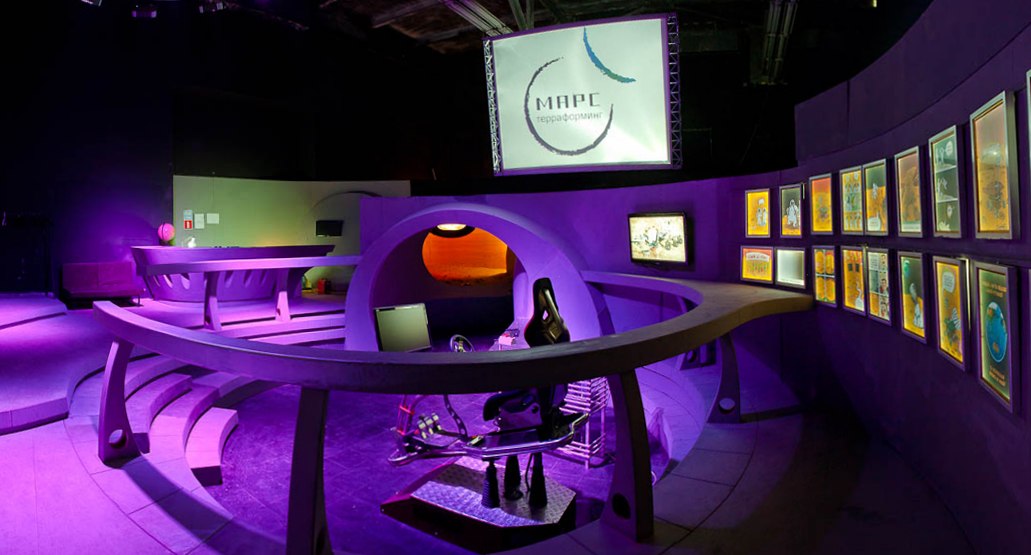
')
Unlike Mars One, they do not promise a flight to Mars by 202 ..., but they offer to play it. During the year they built in the pavilion the layout of the first scientific habitable base, which, according to the game’s plot, should appear on Mars in 2050. In this “Mars-Tefo” is more similar to the station MDRS of the Martian community of the United States.
The project of the base at VDNKh was created in collaboration with Russian scientists, and it is equipped with almost all the necessary elements: a scientific compartment for analyzing the collected Martian samples; the command unit for communication with the Earth, remote control of the rovers and communication with the artificial intelligence base. A reactor block and a solar panel are provided for powering the station. The base is supplemented with a diorama of the Martian surface, "teleport" and "orbital station".
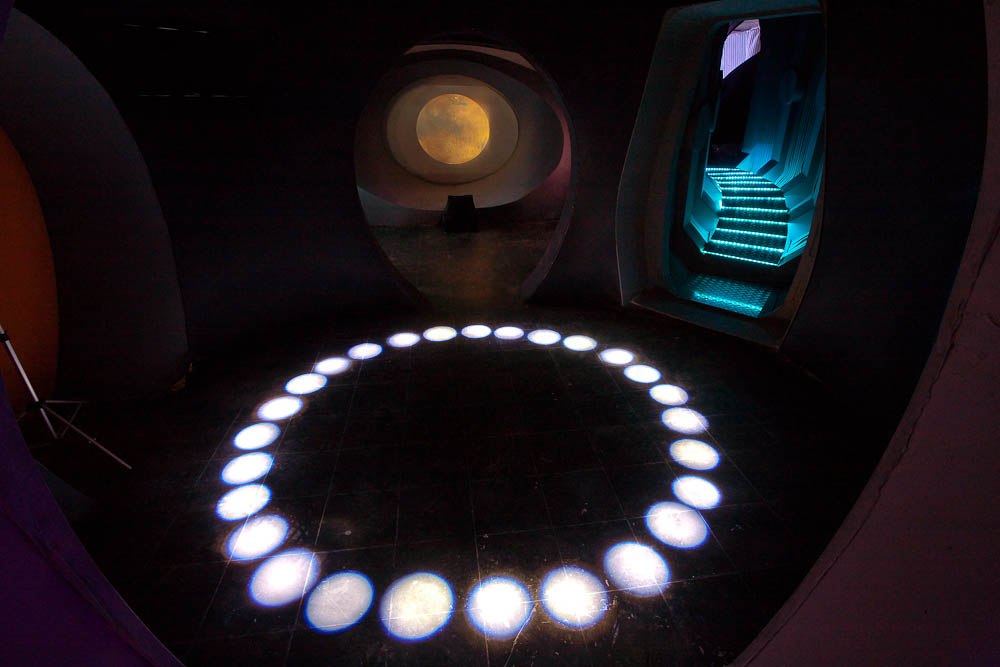
The nuclear reactor is modeled very realistically, it is possible to manually replace the produced fuel elements, for which it is required to put on a spacesuit. But the pride of Mars-Tefo is software that allows you to provide power to the entire Martian station or to bring the reactor to a nuclear explosion. Of course, there are no radioactive materials there, but the power supply to the interior of the base directly depends on the reactor setup and power system management.
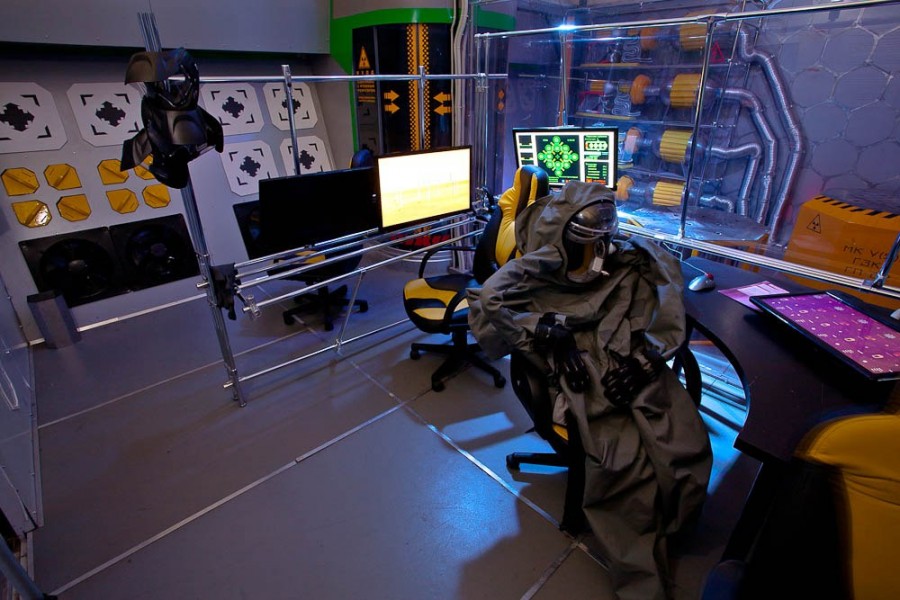
Solar panels are only on the monitor, but the energy of the base also depends on their management.
In the scientific compartment there is a remote control panel for unmanned probes that conduct geological exploration and deliver samples to the base for analysis. The devices are also virtual, but the geological samples are delivered in-kind. Unfortunately, not from the present Mars and not even meteorites, but the rocks were selected related to the fact that they found the real rovers. Samples are delivered in sealed containers, and are opened only in a chemical cabinet with “sleeves” known from numerous science-fiction films about viruses.
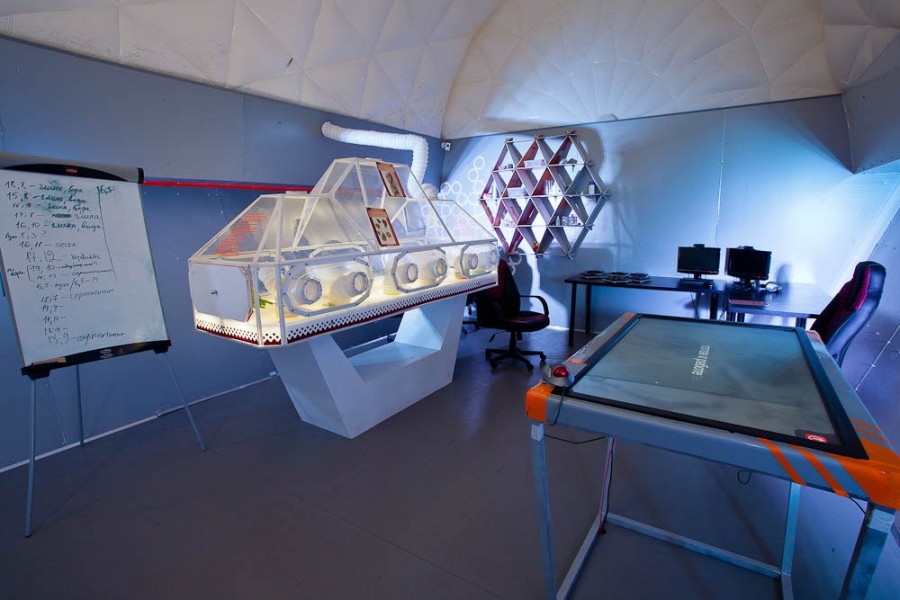
Communication with the Earth, as expected, is carried out with a delay, and in real mode, you can communicate with artificial intelligence, and try to fix his brain when he has a roof. This AI disease is known since the 2001 Space Odyssey and pursues almost all science fiction works.
Separate adventure - taxiing rover. Sit at the helm of Curiosity, you can only in the "Mars-Tefo".
Unfortunately, no one has created a virtual model of domestic all-terrain rovers. But it is a question of the accessibility of the drawings of the apparatus necessary for 3D modeling.
You can play in the Masonauts for three hours, and there are excursions around the station, combined with popular science lectures and master classes. On excursions you can not only walk around the station, but also get acquainted with the details of Mars exploration over the past centuries, learn about spacecraft that studied and study the Red Planet, and the latest scientific data that comes from there.

In appearance, according to the description, "Mars-Tefo" is another attraction, of which there are many at the Exhibition of Economic Achievements, and an attempt to capitalize on the now-fashionable Martian theme. But in reality, it is very difficult to make money in Russia on the popularization of science. As a positive example, one can only cite, probably, the Moscow Planetarium, which, however, is the property of Moscow and cannot, in principle, go bankrupt. The example of the closure of the St. Petersburg Umnicum shows that the popularization of science and knowledge of the world does not promise super-profits, and even the achievement of self-sufficiency is an outstanding achievement.
“Mars-Tefo” was created not only as a business startup, but pursued more ambitious and noble goals. Those who finance and pull this project are guided by the ideas of Mars inspiring a new generation of Russian space explorers.

The previous generation, which began the exploration of space, grew up on science fiction books, but now they have strong competition from computer games and movies. Therefore, Mars-Tefo offers to play Mars not on a computer, but in conditions close to reality. Unlike the space museums, where you can only watch and not touch, the new word “interaktorium” implies that you can touch, steer, load, tune, save, in other words, play.

The truth of the game "Mars-Tefo" reminds the plot of the film "Gravity": everything constantly breaks down, explodes, artificial intelligence goes crazy, alien viruses sneak onto the base, fall meteorites, overheat the reactor ... But this is a feature of the genre, if there is no continuous force -major, it will get boring. Only the list of incidents varies depending on the age of the players. "Improvisation" in advance carefully prepared igrotehnikami. They say that both children and adults have already managed to play marsonauts.
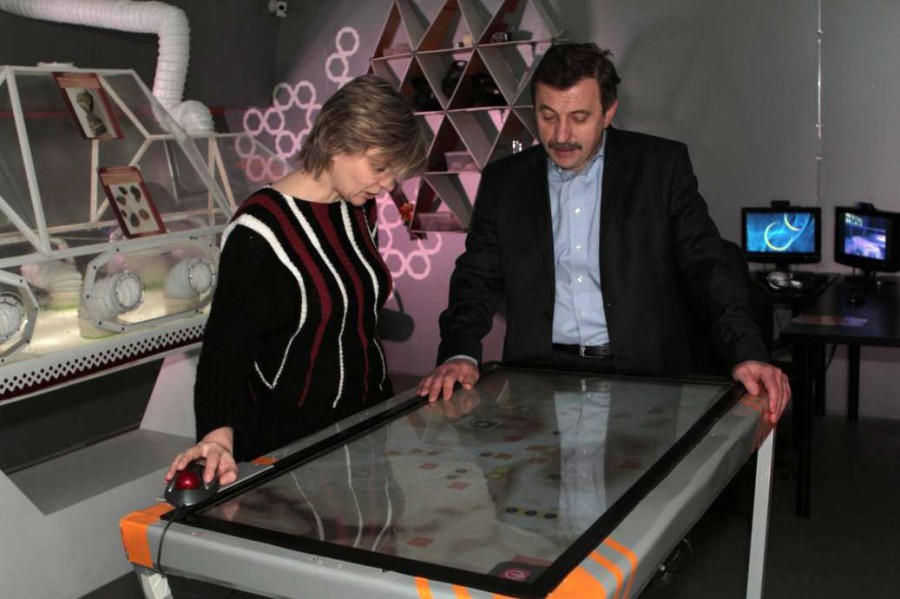
Clearly, the only "Mars" that is hidden in the depths of the Exhibition of Economic Achievements, is physically unable to reach any significant percentage of even Moscow youth. Therefore, the project of the interaktorium initially envisaged the “cloning of Mars” throughout the country on a franchise basis. And recently, a significant event has passed for Mars-Tefo, the opening of a new Mars base in Nefteyugansk. Here the local government took up space education of the younger generation, therefore the local government took a direct part in the creation of the station. The landing of the Moscow "Martians" landed in the Khanty-Mansi Autonomous Okrug, set up a base, prepared local game technicians and conducted demonstration classes.
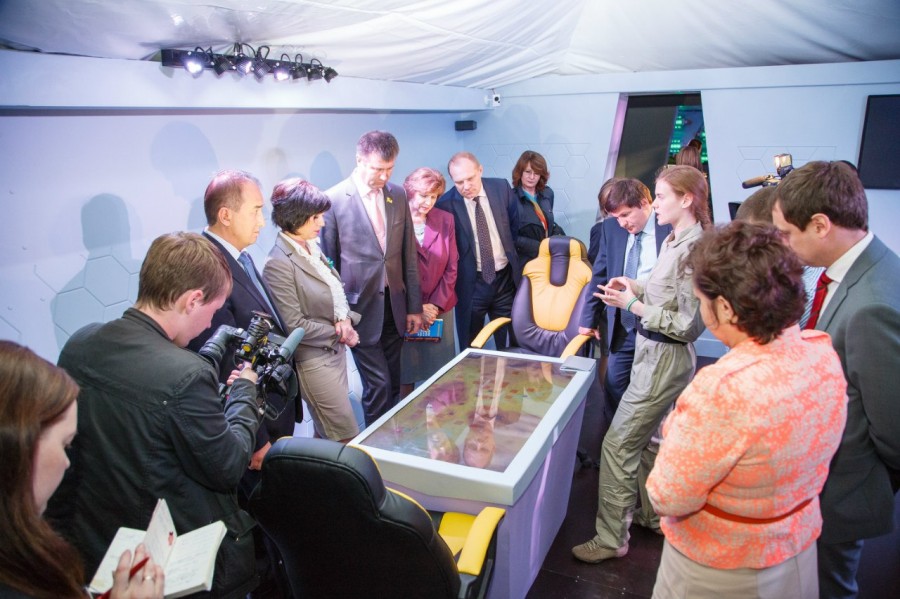
Now they are ready to expand the network of Martian bases in Russia, waiting only for orders from private investors or regional authorities.
I hope there will be such people in the country, and the Mars-Tefo targets in the cultivation of new Korolevs, Gagarins, Armstrongs and Masks will be realized.

Site " Mars-Tefo ", Vkontakte group.
“Dauria Aerospace”, to the extent possible, supports the popularization of astronautics. For example, the company is a co-organizer of the school science and technology competition " CanSat in Russia ", somehow we will tell about it in more detail.
However, in 2012, the left wing of the pavilion was rented by an organization under the faceless name “Development Parks”. But they began to build what they later called the Mars Terraforming Interactorium.

')
Unlike Mars One, they do not promise a flight to Mars by 202 ..., but they offer to play it. During the year they built in the pavilion the layout of the first scientific habitable base, which, according to the game’s plot, should appear on Mars in 2050. In this “Mars-Tefo” is more similar to the station MDRS of the Martian community of the United States.
The project of the base at VDNKh was created in collaboration with Russian scientists, and it is equipped with almost all the necessary elements: a scientific compartment for analyzing the collected Martian samples; the command unit for communication with the Earth, remote control of the rovers and communication with the artificial intelligence base. A reactor block and a solar panel are provided for powering the station. The base is supplemented with a diorama of the Martian surface, "teleport" and "orbital station".

The nuclear reactor is modeled very realistically, it is possible to manually replace the produced fuel elements, for which it is required to put on a spacesuit. But the pride of Mars-Tefo is software that allows you to provide power to the entire Martian station or to bring the reactor to a nuclear explosion. Of course, there are no radioactive materials there, but the power supply to the interior of the base directly depends on the reactor setup and power system management.

Solar panels are only on the monitor, but the energy of the base also depends on their management.
In the scientific compartment there is a remote control panel for unmanned probes that conduct geological exploration and deliver samples to the base for analysis. The devices are also virtual, but the geological samples are delivered in-kind. Unfortunately, not from the present Mars and not even meteorites, but the rocks were selected related to the fact that they found the real rovers. Samples are delivered in sealed containers, and are opened only in a chemical cabinet with “sleeves” known from numerous science-fiction films about viruses.

Communication with the Earth, as expected, is carried out with a delay, and in real mode, you can communicate with artificial intelligence, and try to fix his brain when he has a roof. This AI disease is known since the 2001 Space Odyssey and pursues almost all science fiction works.
Separate adventure - taxiing rover. Sit at the helm of Curiosity, you can only in the "Mars-Tefo".
Unfortunately, no one has created a virtual model of domestic all-terrain rovers. But it is a question of the accessibility of the drawings of the apparatus necessary for 3D modeling.
You can play in the Masonauts for three hours, and there are excursions around the station, combined with popular science lectures and master classes. On excursions you can not only walk around the station, but also get acquainted with the details of Mars exploration over the past centuries, learn about spacecraft that studied and study the Red Planet, and the latest scientific data that comes from there.

In appearance, according to the description, "Mars-Tefo" is another attraction, of which there are many at the Exhibition of Economic Achievements, and an attempt to capitalize on the now-fashionable Martian theme. But in reality, it is very difficult to make money in Russia on the popularization of science. As a positive example, one can only cite, probably, the Moscow Planetarium, which, however, is the property of Moscow and cannot, in principle, go bankrupt. The example of the closure of the St. Petersburg Umnicum shows that the popularization of science and knowledge of the world does not promise super-profits, and even the achievement of self-sufficiency is an outstanding achievement.
“Mars-Tefo” was created not only as a business startup, but pursued more ambitious and noble goals. Those who finance and pull this project are guided by the ideas of Mars inspiring a new generation of Russian space explorers.

The previous generation, which began the exploration of space, grew up on science fiction books, but now they have strong competition from computer games and movies. Therefore, Mars-Tefo offers to play Mars not on a computer, but in conditions close to reality. Unlike the space museums, where you can only watch and not touch, the new word “interaktorium” implies that you can touch, steer, load, tune, save, in other words, play.

The truth of the game "Mars-Tefo" reminds the plot of the film "Gravity": everything constantly breaks down, explodes, artificial intelligence goes crazy, alien viruses sneak onto the base, fall meteorites, overheat the reactor ... But this is a feature of the genre, if there is no continuous force -major, it will get boring. Only the list of incidents varies depending on the age of the players. "Improvisation" in advance carefully prepared igrotehnikami. They say that both children and adults have already managed to play marsonauts.

Clearly, the only "Mars" that is hidden in the depths of the Exhibition of Economic Achievements, is physically unable to reach any significant percentage of even Moscow youth. Therefore, the project of the interaktorium initially envisaged the “cloning of Mars” throughout the country on a franchise basis. And recently, a significant event has passed for Mars-Tefo, the opening of a new Mars base in Nefteyugansk. Here the local government took up space education of the younger generation, therefore the local government took a direct part in the creation of the station. The landing of the Moscow "Martians" landed in the Khanty-Mansi Autonomous Okrug, set up a base, prepared local game technicians and conducted demonstration classes.

Now they are ready to expand the network of Martian bases in Russia, waiting only for orders from private investors or regional authorities.
I hope there will be such people in the country, and the Mars-Tefo targets in the cultivation of new Korolevs, Gagarins, Armstrongs and Masks will be realized.

Site " Mars-Tefo ", Vkontakte group.
“Dauria Aerospace”, to the extent possible, supports the popularization of astronautics. For example, the company is a co-organizer of the school science and technology competition " CanSat in Russia ", somehow we will tell about it in more detail.
Source: https://habr.com/ru/post/226609/
All Articles